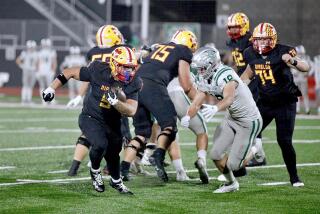Less May Mean More : NCAA-Mandated Scholarship Cuts Could Bring Parity to Division I Football
- Share via
Fewer scholarships each year for NCAA Division I football programs may mean more quality athletes in the Western Athletic Conference and the Pacific Coast Athletic Assn.
Delegates to the NCAA Convention in San Diego voted last month to reduce football scholarships from 30 to 25 in any given year. Basketball scholarships were cut from 15 to 13 for Division I schools. Both rules go into effect Aug. 1, 1988.
“I think the new rule will help us,” said Gene Murphy, Cal State Fullerton football coach. “It’s a matter of supply and demand. The quality athletes should begin to trickle down from the Pac-10 to the WAC and the PCAA.”
Bob Burt, head coach at Division II Cal State Northridge and a former Fullerton assistant, also expects some benefits from the new measure with 50 fewer scholarships being offered by Pacific 10 programs.
“Any time a pool of quality players is spread out it helps a program like ours,” Burt said. “Our biggest problem is that they’ve added the same academic requirements to Division II programs beginning in August of 1988 that were used in Division I this year.
“So, the reduction of scholarships is good for us, but, coupled with the academic standards, means it’s basically a wash for us. Overall, we’ll gain a little, but not a lot.”
Dick Lascola, whose Scouting Evaluation Assn. services 85 colleges, said he doesn’t think the new ruling will hurt athletes’ chances of being recruited.
“When the NCAA first limited the number of scholarships to 30 per year, the schools started redshirting kids and then giving them a ride the following year,” he said. “This was always done according to need.
“Nowadays, you see an awful lot of fifth-year seniors. I see the rule really helping the lower Division I conferences like the PCAA and the WAC.”
El Toro football Coach Bob Johnson has six players being recruited by Division I schools, including blue-chip linemen Scott Spalding and Scott Ross, The Times’ Orange County Lineman of the Year. He doesn’t foresee any changes in the recruiting game.
“I rarely see a school come in here with 25 full rides, and I’ve never seen a guy with 30 scholarships,” he said. “Most of the big schools generally have between 19 and 23 scholarships.
“I just don’t see how this new rule is going to change anything. The top players are still going to be recruited. Especially if they have good grades.”
Despite the yearly scholarship reductions, football programs will continue to have 95 total scholarships. That’s not the case in basketball, and it has left more than one coach unhappy.
Indiana basketball Coach Bob Knight was so angered by the reductions that he suggested the NCAA be disbanded.
“You cannot operate a basketball program today with 13 scholarships,” he said. “That’s impossible. Anybody who would propose that or vote for it is an absolute idiot.”
Orange County coaches may not be so outspoken, but most agree the reduction in players will hurt, especially in practice. Some believe the new rule will help the middle and lower Division I programs. Others think it will have little impact because the 14th and 15th players on most teams don’t contribute much.
“I don’t know a single coach who likes the rule,” said UC Irvine’s Bill Mulligan. “If you find one, give me a call. You’re hurting the student-athlete simply by reducing his chances of getting a scholarship.
“I thought Bobby Knight put it best when he said football programs will still have enough players for four teams and we won’t be able to practice with even three full teams.”
Some wonder if the fringe player will be given a chance in a Division I program with only 13 scholarships available. Schools often take a chance on a player, especially a tall one, hoping he might develop in three or four years.
A classic example is Utah Jazz center Mark Eaton. He didn’t play high school basketball, learning the game at Cypress College. He then attended UCLA and has developed into one of the NBA’s best defensive players.
“Would UCLA have taken Mark Eaton with only 13 scholarships?” said Santa Ana Coach Greg Coombs. “Would he be playing in the NBA?”
Woodbridge Coach Bill Shannon points to former Villa Park center Leon Symanski at the University of Nevada Las Vegas and doubts he would be playing for the nation’s top-ranked team under the scholarship reduction.
“Leon Symanski is not the world’s greatest player, but he’s got a scholarship to one of the best basketball schools in the country,” Shannon said. “Under the new rule, I wonder if the Leon Symanskis of the world will get a chance.
“Then, I look at a player like (6-10 center) Brian Joe at La Quinta. He’s not a player now, but he might develop into one by the time he’s a senior. But are you going to take a chance on him with only 13 scholarships?”
Bolsa Grande Coach Tony Lipold predicts some players will have to be content with attending a Division II school or an NAIA program, but wonders if that’s so bad.
“I have a player, Joe Small, who has received letters from just about every Division I school west of the Mississippi River,” he said. “I certainly don’t want to see him get lost in the shuffle at a big school.
“I want to see him go where he can get some playing time and be happy. I plan on taking my whole team to the Southern California College game on Thursday night. We’re talking NAIA here, and I want my players to see that there’s good talent on that level too.”
More to Read
Go beyond the scoreboard
Get the latest on L.A.'s teams in the daily Sports Report newsletter.
You may occasionally receive promotional content from the Los Angeles Times.










